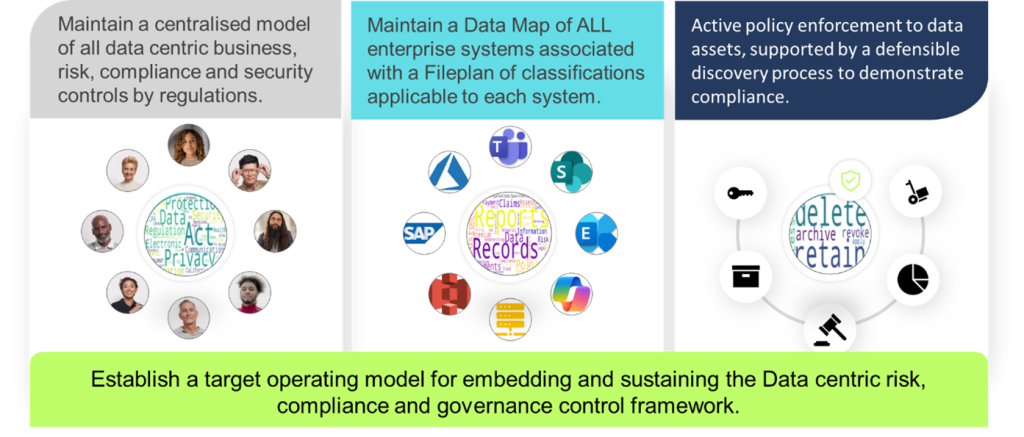![]()
Maximise the benefits of Data Governance in UK Public Sector
Data governance has been a constant consideration of continuously increasing importance to the UK public sector. The growing shift towards cloud platforms is accompanied by a significant rise in cybersecurity threats. Critical considerations include compliance with the Data Protection Act and the obligation of many organisations responsible for National Critical Infrastructure (NCI) to adhere to the guidelines outlined in the Cyber Assessment Framework (CAF) as established by the National Cyber Security Centre (NCSC).
What is Data Governance?
Data Governance is an accountability framework which encompasses the people, processes and technologies required to manage, protect and utilize data assets throughout their lifecycle. Data Governance involves 3 key domains as described below:

Why Data Governance?
Adhering to new regulatory compliance requirements demands effective governance and comprehensive information management. This involves establishing data policies, ensuring data quality, cataloguing data, maintaining data privacy, and implementing master data management. These measures are critical for enhancing productivity, automation, accessibility, and interoperability in both unstructured and structured data management systems. Organizations that consistently refine their data management practices will be better prepared for AI readiness. As a result, organizations in the regulated public sectors must balance:
- Traditional data management (structured and semi structured data)
- AI-ready data management (all data types, including unstructured textual, visual, audio, video, and image data)
The following section provides an outline of the key strategies and solutions offered by Infotechtion to the UK public sector in establishing a complete Data Governance service, encompassing AI adoption readiness and governance.
How Does Infotechtion Deliver Data Governance?
Infotechtion has guided several organisations in the UK public sector towards data maturity as a key consideration for securing the data and governing the users/services identities who access the data during its lifecycle.
This blog provides an outline of our approach and key strategies:
- Scalable Solution Blueprint: by designing a scalable solution blueprint (aligned with UK GOV guidelines) as a unified design that integrates new technologies with existing data management infrastructure and services. This provides a strategic shift to a Unified Data
Architecture with an interconnected data ecosystem. - Automated Data Map: by using Microsoft Purview Data Governance platform, a unified data map is established by Infotechtion services across structured and un–structured data sources. i–ARM leverages this unified Data Map to collect lineage, access, and
classifications for use by Data Owners in Data governance workflow orchestration presented and orchestrated via Infotechtion i–ARM user interface for business and data owners. - Improved Data classifications: by enriching the data with classifications as metadata filters, making it easier for users to find and sort data based on sensitivity, retention, business area, process area, topics and ability to make governance decisions.
Infotechtion solution i–ARM provides operational insights automatically detecting redundant, obsolete, trivial, overexposed, expired data and supports rule / workflow– based remediation orchestrations integrated with existing data loss prevention policies. - Enhancing Information Protection: by using Sensitivity labels to classify files with automatic watermarking and protection. This helps in protecting sensitive information and ensuring compliance with data protection regulations.
- Management of Data centric regulatory compliance and loss risks: by leveraging Data Loss Prevention (DLP) policies to automatically detect sensitive information such as passports, driver’s licenses, and credit cards across Data assets. Additionally, the use of
Retention policies and labels integrated with data classifications, ensuring that data is retained by the system only as long as necessary. Infotechtion solution i–ARM provides Data compliance managers with a centralized view of expired data supported by
workflow orchestrations to review the data before disposal or archival. - Efficient Subject Access Request and eDiscovery process: by integrating Case management configurations, enabling a controlled discovery, collection and response process leveraging the existing Microsoft Purview capabilities.
- Migrating / Integrating data with cloud platforms: by leveraging Infotechtion i–ARM
solution which provides the automated discovery capabilities powered by Microsoft Purview, and supported by AI powered insights and orchestrations to delete / migrate / manage in place / archive data. - User Education and Knowledge Hubs: by providing packaged training and awareness to educate users on best practices for modern work, data management and compliance. This significantly reduces the burden on customers creating their own training, and
leveraging up-to-date training packages that users can access and stay well-informed about the tools and processes in place.Data compliance managers with a centralized view of expired data supported by workflow orchestrations to review the data before disposal or archival.
For UK public sector customers, this means reduced operational costs through automation, enhanced data governance, and vigilant data centred risk management. Our strategic approach includes creating a benefits case based on the following principles:
- First evaluate requirements and needs against the current technical solutions inuse.
- Evaluate functionality lacking in the current Data management scope against Microsoft Purview integrated with Infotechtion data governance add-on i-ARM.
- Establish Total cost of ownership to implement and operate against expected benefits from upgrading the licenses to i-ARM.
- Demonstrate the value of upgrading through accelerated proof-of-concepts.
The top 3 benefits UK public sector is benefiting from unified Data governance services are:
- Cost effective and natively integrated controls for data centric security, risk and governance.
- Reduced costs for defensible lifecycle governance, discovery, case management and disposition process.
- Optimise operational, legal and regulatory costs of data sprawl governance.
Implementing a blueprint which aligns with UK GOV, CDDO and NCSC standards, the data maturity controls can be significantly simplified resulting in reduced costs remediations through policy controls which are automatically applied to data (where it lives), ensuring data is:
- A valued asset
- Managed
- Fit for purpose
- Standardized and linkable
- Re–used
- Protected based on privacy and sensitivity
- Easily accessible for public enquiries process
Infotechtion’s public case study with Food Standards Agency is exemplary of our strategic value to customers in the UK public sector. Leveraging lessons learnt from other UK public sector implementations, known solutions to Microsoft product gaps and Infotechtion packaged add– on (i–ARM) to deliver ready insights on your data and automate migrations to M365 fully aligned with the target solution blueprint and operating model.
Infotechtion Overview
Infotechtion specializes in leveraging Microsoft 365 tools to deliver best–in–class information governance to organizations. We empower clients to fully understand and safeguard their data across its entire lifecycle, optimizing data governance within Microsoft 365 and on–premises. This includes ensuring essential data is retained and unnecessary data is securely deleted.
Infotechtion offers a range of services & solutions designed to help organizations in the UK public sector maximize the value of their Microsoft licensing suite. These services focus on establishing an architecture baseline and enhancing information governance, compliance, and data protection within the Microsoft 365 environment.
We hold several advanced specializations in Microsoft technology, an elite Microsoft design partner and services available via UK GOV digital marketplace as part of G–Cloud 14.



